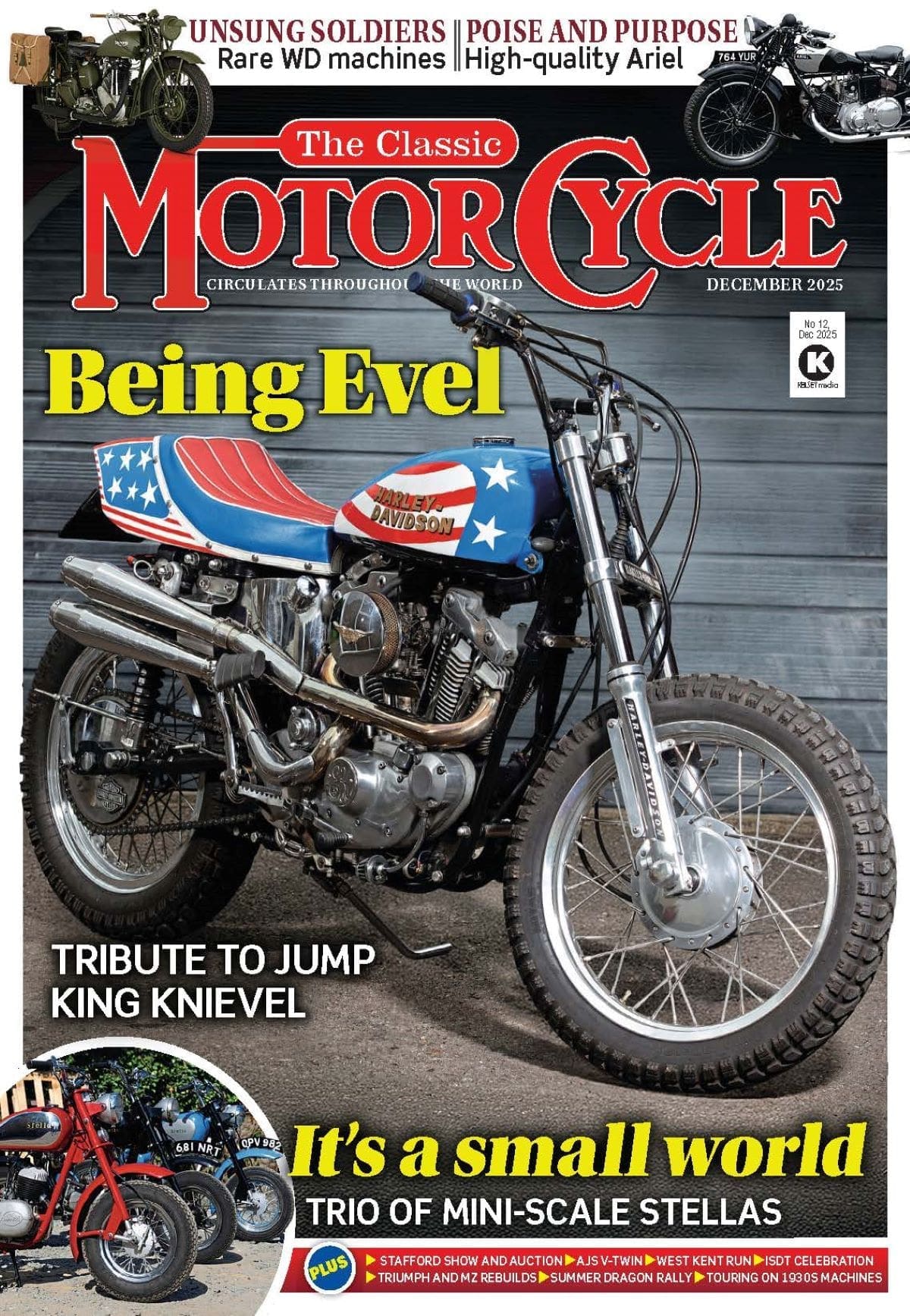This special doesn’t perhaps visually appeal to all, especially with its rather out-there colour scheme, but it is possessed of a wonderfully agreeable engine.
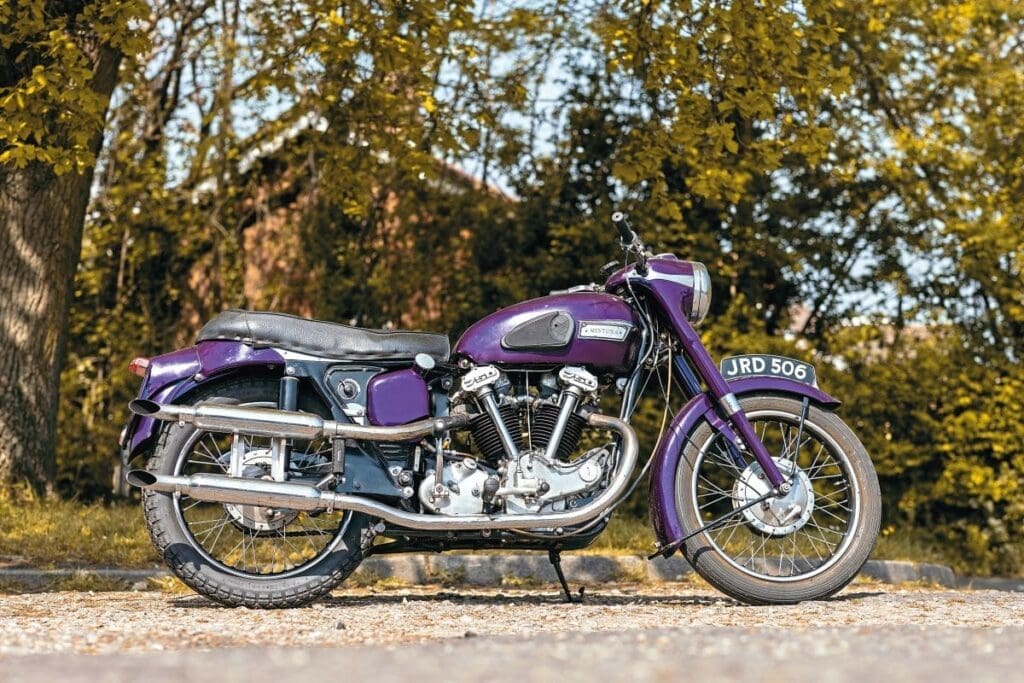
Words: James Robinson Photographs: Gary Chapman
Having looked at this BSA-powered Ariel in real life, more than once in fact, and having gone over the pictures several times too, I’m still undecided – is it a brilliant period special which should be maintained as it is, or is it a monstrosity that deserves breaking and its exquisite engine relocating to a more suitable home?
Like all these things, really it’s neither black nor white, but, for me, somewhere in the middle. Grey maybe, but the machine before us is anything but ‘grey’ and dull that’s for sure. It’s purple, for a start…
Enjoy more The Classic MotorCycle Magazine reading every month.
Click here to subscribe & save.
The paint finish is particularly suitable in some ways, as the chosen hue is a secondary colour, made from combining two others, just like the motorcycle itself. Though there’s actually probably more than two machines gone into this creation, the two are the most obvious, it being a mix of 1950s Ariel and 1930s 750cc BSA V-twin. The resultant beast has had me pondering aplenty. What would improve it? Does it need improving? Or should it just be left as it is, an example of the personal nature of the special builder’s art?
This machine – which is for sale with our friend, Suffolk-based dealer Andy Tiernan, www.andybuysbikes.com – has an unusual history, insomuch as, apparently, the motorcycle was discovered, abandoned, in some woodlands in the 1970s. Now, most of us have only unearthed far more unwanted, abandoned rubbish; having grown up on the edge of Breckland Forest, as child I spent a lot of time roaming in the woods; purloined prams, stolen bicycles, abandoned lawnmowers and the occasional fly-tipped settee was about as good as we ever came across. The discovered BSA’s engine was removed from its well-worn chassis and came into the hands of an enthusiast based near Portsmouth, who created this special, using an Ariel rolling chassis, plus various other parts – apparently, the petrol cap comes from a Saab car. The headlamp nacelle is Triumph, while the rear mudguard has more than a hint of Royal Enfield about it.
Once the special was finished, the builder/owner, who was a skilled carpenter, clocked up several thousand miles on it, and when it was not being ridden it was stored in the front room of his dwelling, along with another 17 classic machines; it was apparently a large bungalow…
The front room was given over to the motorbikes, but the place was, says Andy, ‘lovely.’ Pretty much sounds ideal to me. On the builder/owner’s passing, all the other motorcycles were sold before Andy acquired the machine from his family. The special sports a July 1954 registration number and was originally from Reading; it’s now recorded on the V5 as a purple 750cc Ariel, though there is an old logbook showing in its earlier, Ariel days, it had ended up in Liverpool, going through well known dealer (and ex-TT and Brooklands racer/tuner) Victor Horsman’s dealership.
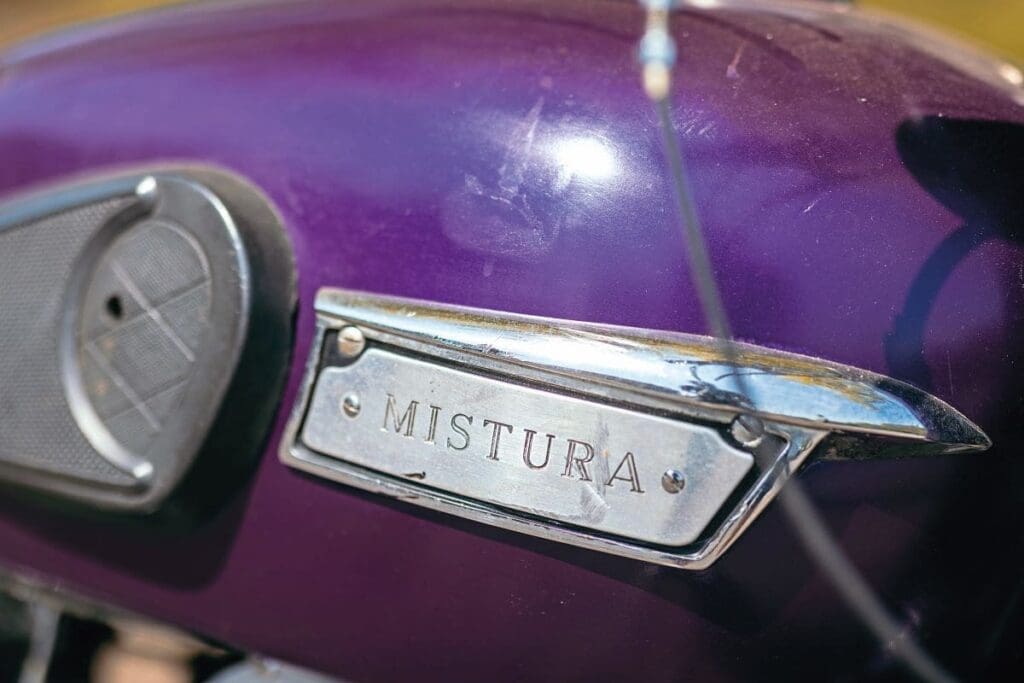
Andy Tiernan has a personal affection for all BSA V-twins, and has several examples himself, so I was wondering why he wouldn’t want to keep the Beesa special? He said: “Where do you stop and start? I did look at it and was tempted to keep it or perhaps build it back into a Y13, as there was a frame kicking about which we thought might be the original one for this engine, but it wasn’t. I’d have been more inspired if it had been, and perhaps taken it on, but there’s only so much Ican do.”
As a result, this one is for sale at £16,000. Reckons Andy: “Most specials, especially V-twins and however well they’re done, you struggle to make anything more than the value of their component parts… Obviously, the value of this bike is in its engine.”
The standard Y13 was launched in 1936, when it joined in BSA’s range the 500cc V-twin version, the J12, which had originally come about in civilian form in 1934 (J34-11, with 1935 J34-12), with it rather incongruously intended as a military motorcycle, with the first supplied in late 1933 – incongruous as the armed forces tended to prefer simpler, more rugged types and, of course, would go back to them, with the 126,000 M20s supplied during the 1939-1945 Second World War as the example. This compared to the circa 700 500cc V-twins ordered between 1933 and 1936.
On its launch in late 1935 (a 1936 season model) the 750cc version, the Y13, was afforded what is an illuminating write up, insomuch as it explains that the Y13 wasn’t simply a bore and perhaps stroked version of the smaller twin, but actually a largely new model.
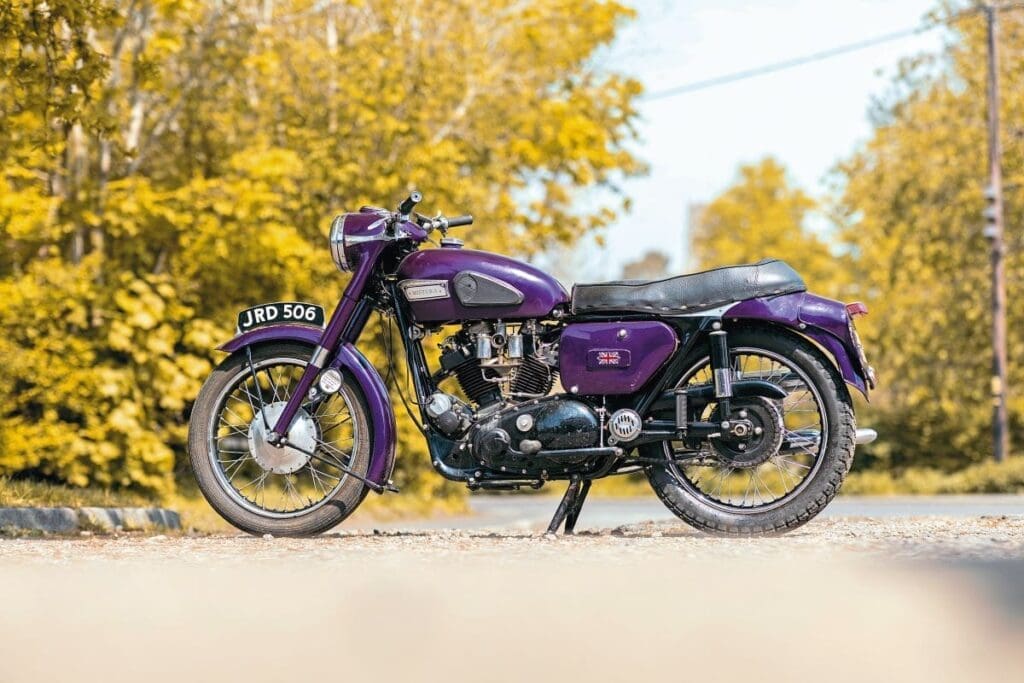
From The Motor Cycle, October 3, 1935: “Model Y13, though founded on the same lines [as the J12], is new, and has a 748cc (bore and stroke 71×95.5mm) overhead valve engine with cylinders set at 45 degrees. The crank unit is remarkably sturdy and has twin bearings on the drive side. The big-end arrangement is interesting, for instead of the bearings being placed side by side, as in the smaller twin, a forked connecting rod is used. There are two rows of half-inch rollers in the crank pin, shrouded by a hardened-steel sleeve which is pressed into the eyes of the forked rod. On this sleeve works a bronze bush, mounted in the central rod. The forked rod is webbed, and the forks joined round the periphery with a gap only large enough for convenience in erection, and to provide room for the small swing of the central rod. The system, and indeed the whole engine, has proved most satisfactory under prolonged test and there is no doubt that the new twin will be one of the stars of the BSA range.”
The description then goes on to explain about the chassis – forged backbone chassis and ‘26x4in’ tyres, which is actually 19inch wheels – all of which is of no real relevance to our feature machine, owing to its rehousing.
A couple of weeks after The Motor Cycle description, a thorough road test of the newcomer appeared in Motor Cycling, complete with what could be construed as, perhaps, a slightly barbed comment. It went thus: “The BSA Company has, deservedly, a high reputation, not only for the quality of its products, but for their silent and unobtrusive behaviour in service, and when Motor Cycling learnt that a 750cc ohv twin model was to appear in the 1936 programme, it immediately made arrangements to publish the first details of its behaviour on the road.”






‘On the road’ is the bit which perhaps is aimed at the write up from The Motor Cycle? However, the feature – published in the October 16, 1935 issue – then rather obsesses about what it construes to be the most important feature of a new motorcycle – the noise it makes…
“For here was a machine designed first and last, and in the widest sense, for modern conditions, in which silence plays an important part.”
Now, unless motorcyclists have changed wholesale, not only since the period up to the date of the test and the period since, ‘silence’ has never been an important part, not for the vast majority anyway. It’s the old trap that so many manufacturers have fallen into over the years, backed up by the regular letter writers to the weekly press, detailing their ‘ideal’ machine, which led to the likes of – at opposite ends of the scale – the Velocette LE and enclosed Vincent V-twins, which hardly anyone bought, with police purchasers being the saviour of the LE. Or at least the public didn’t buy in the numbers required to make them sustainable and profitable, while the majority of young enthusiasts – needed for the industry to survive and have a future – pretty much ignored these idealised offerings and went back to B31s and Triumph twins with upturned handlebars and home-made ‘meggas.’
Motor Cycling’s Y13 write up continues, with something that would be of more interest to red-blooded younger (and older) readers:
“Such a machine, however, if it is to find favour, must have a number of virtues in addition to that of silence. Present day road conditions demand such qualities as rapid acceleration and, on occasion, sustained high-speed.”

That’s more like it! Even Motor Cycling seems to acknowledge it was thus: “In fact just those qualities which the public has, in the past, sometimes found missing in motors where silence was a leading characteristic.” I spent a bit of time pondering what they meant – I came up with the decade-and-a-half earlier ABC flat-twin and the five years since side-valve V-twin Matchless Silver Arrow – but any other ideas, let me know.
When it was launched, the Y13 cost £75 dead, exactly the same as the 1000cc G14 side-valve, and opposed to £70 for the 500cc J12; incidentally, the most expensive 500cc BSA single, the ohv Empire Star, was £63-10s. Other new-for-1936 models included 350cc Velocette’s Mk.II KSS at £62-10s, Vincent-HRD’s 1000cc V-twin Rapide £138, and the attractive MG TA was £222. Incidentally a Matchless-engined SS100 Brough Superior was £140, though the spring frame job was £10 more. Brough sold 16 SS100s that year…
Over its three years of production, numbers of Y13s made were certainly more than those SS100s, but seem to be hard to ascertain, with numbers from 1600 to 750 touted in various places. This bike has the engine number JY13 – the ‘J’ indicates 1938. D is 1936, H is 1937, then J is 1938. Hence JM24 (1938) and KM24 (1939; the K being 1939) pre-Second World War Goldies. How the number of production Y13s was split, it’s hard to be sure, but one suspects that there were more in the earlier model years, as of the few that do come up for sale, they seem to generally be 1936 or 1937. I asked Andy Tiernan (who has a Y13 of his own) how many he reckoned were made. He said: “My feeling is that about 1200-1300 were built, about the same number as Rocket Gold Stars, coincidentally. The primary year for the Y13 was 1936, with 400 or 500 made, then they tailed off. There were some made in 1937 and 1938, in decreasing numbers year-on-year, while I think there was perhaps the odd one made in 1939. But most you’ll see are 1936.”
Andy had another Y13 through his business relatively recently, its Irish owner selling it to mainland Europe, it being advertised on Andy’s website on a commission basis for its custodian, who’d bought it from Andy; apparently, the owner was only selling it as he had another one too. That machine ended up in Belgium, Andy thinks. As for value, Andy reckons ‘around £35k’ though some have sold for a bit more. Meanwhile, Bonhams have one already consigned (a 1936, no surprise) for its April Stafford sale, its estimate a typical ‘tempter’ at £16,000-20,000. At that price, there’ll be a queue forming…
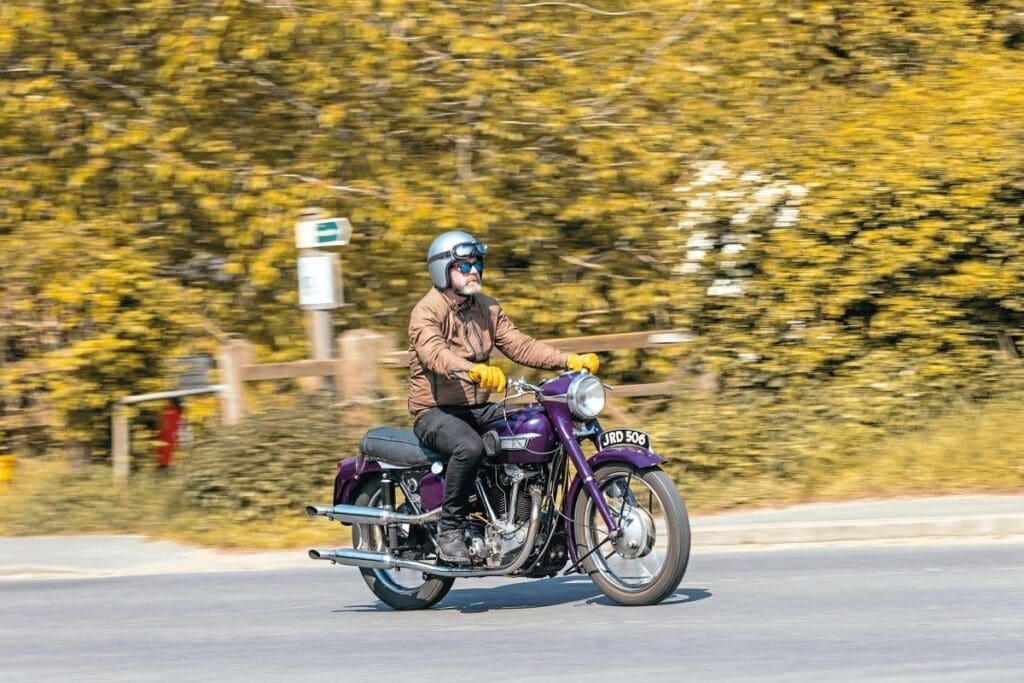
I asked Mike Davis at H&H what he’d value a Y13 at, if he had a ‘minter’ to sell; coincidentally, Mike’s dad John has just such a thing, as well as a matching J12, so they’re well acquainted with the model. He said: “I’d have to say that I think, in my opinion, an immaculate, all matching numbers Y13, in concours condition, would be somewhere of the region of £40,000.” Which largely ties in with what Andy thinks, too. And, in full disclosure, there’s a J12 (well, a J34-11 if we want to be pernickety, or to that spec, although it was probably initially supplied to the forces. Most people call them J12s from my experience; the rebuild of dad’s bike was written about in the Winter 1978/79 issue of Classic Bike by its restorer, who refers to it as a J12 throughout) in our family too, my dad having bought it in 2009, while Phillip Tooth did a feature on dad’s bike too, printed in TCM, April 2014. The Y13 is a rarer fish though; we’ve only ever featured them sparingly; in the second ever issue of The Classic MotorCycle (August/September 1981) and February 1991, the latter of which I remember being transfixed by as a child, especially when it would occasionally appear at VMCC club runs local to us; it was one of the most handsome motorcycles I’ve ever seen. Then Roy Poynting rode one for the December 2000 issue, too.
Though I’ve never been particularly obsessed with V-twins (I’ve been trying to work this out; I think they always seemed unobtainable in my younger days, my ownership ambitions were more modest and such a machine seemed so far beyond my means…) I have ridden my dad’s 500 for a number of miles, while I also had a good ride on one restored by Robin James Engineering Services and featured in our March 2017 number. They are/were both fine machines, but I’ve never totally ‘clicked’ with dad’s, there’s other things I prefer to ride; for the most part, I prefer my 500cc mounts to be singles, I’ve realised. But one has to agree, those 1930s ohv V-twin BSAs are undeniably incredibly handsome looking machines.
That’s not a charge which can be levelled at our subject machine, not to my eye anyway. Of course, that engine remains glorious, but the cycle parts; well, not so much. But with the absence of a Y13 crossing my path, it still afforded an opportunity to sample that engine, and experience the (expected to be smooth) power delivery of the 750cc engine.

The beast fired up easily, quickly settling down into tickover, a flip of the twist grip producing a lovely noise; not too quiet, I noted, though not unobtrusive. Settling on the saddle, the handlebars felt probably Triumph too, with a slight upturn not to my liking, while I also found the front brake lever a bit awkward, though a bit of manipulation moved that round the bar to a more comfortable position. Setting off, the V-twin engine gathered itself up and moved impressively, though the power delivery and characteristics of the engine definitely felt ‘older’ than the cycle parts; perhaps this was a psychological trick, but the combination of a Triumph nacelle and handlebars meant I expected Triumph-esq performance. In fact, the special (which has ‘Mistura’ on its petrol tank, incidentally, which has a few apparent mythical and meanings, but is Italian for ‘mix/mixture, blend’) was pretty much the polar opposite. Changing gear didn’t really seem necessary, as it just basically went, however high the gear.
While photographer Gary and Phil Turner busied themselves with other tasks, I just had a ride about, settling into the machine quite happily, loving its smooth, delightful power. Slowly down to low speeds and then pulling away in top gear was no bother at all. While using the gearbox and revving it a bit more made progress impressively brisk; it goes pretty well indeed.
As I was riding, I was thinking, if it were mine, there’d be a few things I’d alter, like the handlebars, though really, it’s actually nicely sorted and a pleasure to be astride, a mix of perhaps the best of pre- and post-Second World War.
It does seem a shame that the fate of the special is, perhaps, to be split apart, as it represents what could be, with a little bit of time and effort, a glorious motorcycle. Though I’m not sure if I could leave it purple though.



